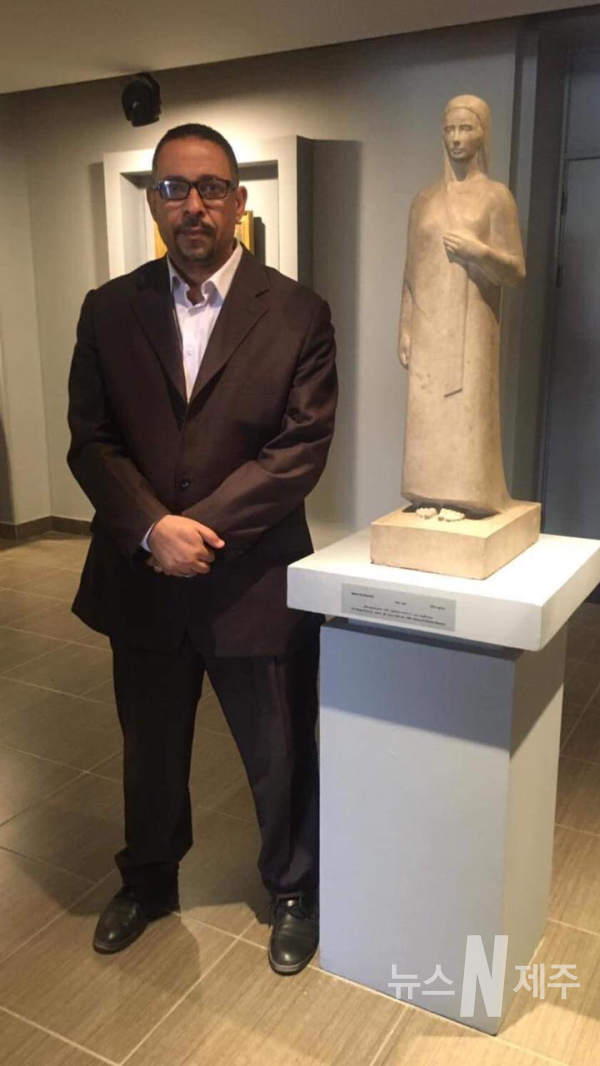
레다 압델 라힘(Reda Abdel-Rahim) 박사는 1972년 이집트의 탄타 서부 지방에서 출생하였다. 이집트 고고학박사로 고대유물부 선임 연구원이며 이집트 작가연합의 실무담당이고 역사연구를 위한 협회회원이다.
그의 저서는 다음과 같다.
"Cry Naous", General Authority for palaces of culture, Cairo 2015.
Two plays under the title "the trial of Herodotus, Khufu's secret letters", daralnha publishing, Cairo 2016.
Book days in Tokyo (from trekking literature), daratalus for printing and publishing, Cairo 2018.
a book inspired by antiquities, Dar dada for printing and publishing, Alexandria 2021.
Japan book roots and approaches, Bettina publishing house, Cairo 2022
이집트 작가연합에서는 2018년부터 2022년까지 이집트 문학진흥에 이바지한 공로로 레다 압델 라힘(Reda Abdel-Rahim) 박사에게 기념 메달을 수여했다.
그는 고대 이집트 유물 분야에서 다수의 과학 및 문학 연구를 수행하여 정기 간행물 및 학술 서적에 게재하였으며 그의 작품과 기사는 Al-Ahram daily, Akbar Al을 비롯한 여러 이집트 잡지 및 신문에 게재되었다. -Adab, al-Jamahiriya, Journal of Literature and Critical, Merit Cultural Magazine, Doha Magazine, Sharjah Cultural Magazine 등에도 게재디었다.
카이로 대학, 탄타 대학, 카프 엘 셰이크 대학, 지그재그 대학에서 열린 많은 과학 회의와 고대 이집트 유물 분야에 관한 연구에 참여했다.
하트셉수트여왕, 남자 복장의 여성
레다 압델 라힘(Reda Abdel-Rahim) 박사
하트셉수트여왕은 이집트를 다스린 가장 두드러지고 강력한 여왕 중 하나였다. 그녀는 십팔 대 왕조 출신으로 기원전 1508년에 태어났다.
그녀의 아버지는 투트모세 1세, 어머니는 여왕 아모세, 그녀의 형제는 투트모세 2세이며, 조카는 투트모세 3세이다.
하트셉수트여왕은 아버지의 통치가 끝날 때 정치에 참여했으며, 수년 후 아버지가 죽자 정권 일체를 장악했고, 남성복을 입은 채로 신전에 자신의 모습을 그려 나타내기 시작했고 나성 대명사로 칭하였다.
그것은 왕좌에 앉은 여성이 남성과 굳이 별다를 것이 없다고 사람들이 믿게 하려고 한 것이었으며, 그 후 그녀는 자신을 위해 일부 신하를 선택했다. 그중 가장 중요한 인물은 "센무트(Senmut)"로, 그녀를 위해 디르 엘바하리 장제전(Deir el-Bahari temple)을 건설한 기술자이다. 이 신전은 지금까지 건설된 가장 위대하고 아름다운 그리고 사치스러운 신전 중 하나이다.
센무트는 그녀의 딸인 "네프루라(Nefru Ra)"의 교육을 맡았으며 그녀는 그 후 여왕으로 선언되었지만 어렸을 때 죽었다. 하트셉수트여왕은 통치 권한을 강화하기 위해 자신의 출생 이야기를 과장했으며, 그녀는 자신이 신 "아몬(Amon)"의 딸이라고 주장했다. 그녀는 이것을 자신의 신전에 기록하여, 아버지가 지배자에 대한 충성을 맹세했다고 기록했으며, 그녀의 형제와 조카, 투트모세 2세(Thutmose II)와 투트모세 3세(Thutmose III)가 그녀의 권리를 빼앗았다고 주장했다.
하트셉수트여왕은 힉소스(Hyksos)가 파괴한 신전을 재건하는 데 신경을 썼다. 그리고 그녀의 시대에 이집트의 국경은 시리아와 팔레스타인 사이로 제한되었으며, 그것은 그녀의 평화로운 정책 때문이었다.
하트셉수트여왕은 남쪽을 정벌했는데, 그 이유는 시리아와 팔레스타인의 사람들이 이집트의 주권에 반란을 일으켰기 때문이었다. 그녀는 이것을 신전 입구에 기록하여 배치하였다.
이 신전은 고대 역사 유적물의 걸작이다. 그것은 서쪽 대륙의 산 안에 있다. 3500년 전에 건립되었으며, 그것은 좋은 땅에 자신의 기억을 영원히 남기기 위해 건설되었다. 디르 엘바하리 장제전(Deir el-Bahari temple)은 웨스트 뱅크(West Bank)에 있는 무덤 군락이며, 최근에 40구의 시체가 발견되었다.
디르 엘바하리 장제전(Deir el-Bahari temple)에는 세 개의 신전이 있으며, 그 뒤에는 왕들의 가장 유명한 무덤인 왕의 계곡이 있다.
이 신전은 세 층으로 구성되어 있다.
첫 번째: 새를 사냥하는 그림과 아스완(Aswan)에서 신전으로 오벨리스크를 운반하는 모습
둘째: 펀트배 여행을 묘사
셋째: 축하를 위한 현관
이 신전은 여왕을 스핑크스 형태로 나타내는 상승 도로로 구성되어 있으며, 우리를 첫 번째 평평한 뜰로 안내한다. 이곳에는 펀트(Punt)에서 가져온 나무 그루프, 두 개의 물 통 및 데이퍼스 식물이 있으며, 서쪽에는 오른쪽과 왼쪽에 각각 22개의 기둥과 16개의 능선을 지닌 두 개의 발코니가 있습니다.
"오시리스(Osir)" 형태의 조각상이 있으며, 죽음의 신, 그 길이는 7m이며, 그 위에는 글과 두 개의 오벨리스크가 있다. 그리고 그 뒤에 두 번째 뜰이 있다. 이것은 10m의 폭을 가진 도로로 아치형 벽이 둘러싸고 있으며, 이곳을 보호하기 위해 사자 형태의 조각상으로 시작되며, 오른쪽과 왼쪽에 22개의 기둥이 있는 두 개의 발코니가 있다.
남쪽에는 "하토르를 위한 예배용 작은 사원(for worship Hathor)"이 있으며, 두 번째 부분은 바위에 새겨졌으며, 16개의 기둥과 색칠된 양각이 있는 두 개의 전당이 있으며, 천장은 하늘과 별을 나타내고, 행성을 나타낸다. 오른쪽에는 신성한 출생의 장면이 기록되어 있다.
하트셉수트여왕은 능력 있는 여성이었지만, 그녀의 남편과 의붓아들에 대한 공격적인 태도로 투트모세 3세를 그녀의 적으로 만들었다. 그가 기회를 갖게 되자 그는 가장 심하게 그녀에게 복수했다. 우리는 하트셉수트여왕의 삶이 어떻게 끝났는지 알지 못하지만, 그녀의 몸이 최근에 발견된 것은 확실하다.
투트모세 3세는 그녀의 기념비를 철거하고, 그녀의 이름과 그녀를 따르는 모든 사람들의 이름을 삭제했으며, 그녀와 가까운 사람들의 무덤을 파괴했다. "우리가 죽을 것이다"라는 묘비명을 포함하여.
그녀는 18년 동안 통치를 했다. 하트셉수트여왕은 기원전 1457년 1월에 사망했다.
Hatshepsut, the woman who dressed like men
By Dr. Reda abdel-Rahim
Hatshepsut was one of the most prominent and powerful queens who ruled Egypt. She belonged to the Eighteenth Dynasty and was born in 1508 BC.
Her father was Thutmose I, her mother, Queen Ahmose, her brother Thutmose II, and her nephew Thutmose III.
Hatshepsut participated in the government at the end of her father's rule, and after years her father died and she assumed all the affairs of government and began to paint herself on the temples while she was wearing men's clothes, where she spoke in masculine pronouns, and that was to delude the people that there was no change with a woman sitting on the throne, and after that she chose some employees for her, and the most important of them "Senmut", who is the engineer who built the Deir el-Bahari temple for her, which is one of the greatest, most beautiful and most luxurious temples ever built. Senmut took over the supervision of her daughter, "Nefru Ra", who declared her queen after that, but she died when she was young. Hatshepsut claimed the story of her birth so that she would have the right of ownership to rule, and she said that she was the daughter of the god "Amon". And she wrote this down on her temple, so she recorded that her father pledged allegiance to the ruler, and that her brother and nephew, Thutmose II and Thutmose III, usurped her right. Hatshepsut took care of rebuilding the temples that the Hyksos demolished. And the borders of Egypt in her era were confined between Syria and Palestine, and that was due to her peaceful policy, and Hatshepsut campaigned to the south, because the people of Syria and Palestine revolted against Egyptian sovereignty. by placing it at the entrance to her temple.
This temple is a masterpiece of ancient historical monuments, as it is located in the interior of the mountain on the western mainland. It was established 3,500 years ago, and it was ordered to be built to perpetuate its memory in a good land. Deir el-Bahari is a group of tombs on the West Bank, and 40 mummies were recently found. Deir el-Bahari contains three temples and behind it The Valley of the Kings is the most famous tomb of the kings.
The temple has three floors
The first: Pictures of hunting birds and transporting obelisks from Aswan to the temple
The second: depicting a punt trip
Third: foyer for celebrations
The temple consists of an ascending road that contains statues of the Queen in the form of the Sphinx and leads us to the first flat, which is an open courtyard that contains a group of trees brought from Punt, two basins of water and papyrus plants, and there are two balconies in the west on the right and left, and each balcony bears 22 columns and 16 ribs, and there are statues It has the form of "Osir", the god of death, its length is 7 m and it contains inscriptions and two obelisks, then after that the second surface: it is a road with a width of 10 m bordered by arched walls and begins with a statue in the form of a lion to protect it and contains two balconies with 22 columns on the right and left and on the south there is a small temple "for worship Hathor" and the second part is carved in the rock, with two halls with 16 columns, and 12 columns with colored capitals, and its ceiling represents the sky and the stars, and represents the planets, and on the right recorded scenes of the sacred birth.
Hatshepsut was a capable woman, but her aggressive attitude towards her husband and her stepson made Thutmose III an enemy to her. When he had the opportunity, he took revenge on her most severely. We do not know how Hatshepsut's life ended, but it is certain that it was a tragic end, because her body was only recently found. Thutmose III demolished her monuments, removed her name and the names of everyone who followed her, and destroyed the tombs of those close to her, including "we will die."
Thus, her 18-year rule ended, and Hatshepsut died in January 1457 BC.


